The 2025 Old Farmer’s Almanac Forecasts a “Calmer, Gentler” Winter

The 2024–2025 Winter Forecasts Are Looking Very Different Than Last Year!
As sure as the Sun rises and seasons change, The Old Farmer’s Almanac returns every year! The 2025 edition is now in stores in the U.S. and Canada, from sea to shining sea. With our official release, we also unveil the full winter map—adding CALIFORNIA, Alaska, and Hawaii. See the 2024-2025 Winter Weather Forecasts—as well as highlights for ALL 18 U.S. regions. Plus, find out what’s inside the new 2025 Almanac!
Find the weather predictions for the Canadian Almanac, too! See our 2024–2025 Winter Weather Outlook for Canada.
ADVERTISEMENT
What Is the 2024–2025 Winter Forecast?
As has been true in every year since 1792, the newest edition features a healthy dose of wit and wisdom, as well as the Almanac’s much-anticipated, traditionally 80 percent–accurate weather forecasts.
“This winter, temperatures will be up and snowfall down throughout most of the United States,” reports Carol Connare, the Almanac’s editor-in-chief. “While there will still be plenty of chilly temperatures and snow for most slopes, the high heating costs associated with the season shouldn’t hit so hard. We’re predicting a temperate, uneventful winter—potentially a welcome reprieve from the extremes of recent years.”
There will be exceptions, of course. Winter rainstorms will leave Florida, the Deep South, and southern California soaked. Meanwhile, heavy snowfall is expected in central and southern Appalachia, the western Ohio Valley, and the Rockies—calling all skiers and sledders!
See the General Weather Report in The 2025 Old Farmer’s Almanac for more details on predicted atmospheric, solar, and climatic patterns.
What’s Inside the New 2025 Almanac?
There’s more! The 2025 Old Farmer’s Almanac also explores how tomatoes (once dismissed as “odious and repelling-smelling berries” by The Horticulturalist) became North America’s favorite vegetable, the surprising Canadian history of America’s favorite pastime, and why incidences of “white dragons” (aka avalanches) are on the rise. In addition, the Almanac looks into whether Earth is on a collision course with the collection of space rubble known as Bennu!
The 2025 Old Farmer’s Almanac also invites readers to have fun and flourish by learning how to:
- Trick a garden located anywhere into growing (almost) anything
- Start and care for a backyard flock of chickens
- Catch, cook, and truly appreciate Nature’s original “fish sticks”—that is, smelts!
- Garden by the cycles of the Moon
- Understand and interpret the curious behaviors of cats
- Find health and happiness in a cup of tea
- Give the perfect hug (or just replicate its feeling and benefits)
The brand-new edition includes all of this, plus the Almanac’s “Trends” predictions for 2025, the humor of Anecdotes & Pleasantries, Mind-Mangling puzzles, award-winning holiday recipes, weather forecasts for all 18 regions of the U.S. (including Alaska and Hawaii), and so much more!

Where to Buy the 2025 Almanac
The 2025 Old Farmer’s Almanac is available in stores wherever books and magazines are sold.
- Support local booksellers whenever possible! A full list of stores that carry the 2025 Almanac is available at Almanac.com/Wheretobuy.
- You can also order your copy of the 2025 Almanac on Amazon.
- Or, find many more options—from classic paperbacks to hardcover editions to special collections—at Almanac.com/Shop.
You will also receive our FREE Almanac Daily newsletter. We will never share your information.
Regional Forecast Summaries for the United States

Region 1: Northeast (Including Eastern New York)
In the Northeast—Massachusetts, Vermont, New Hampshire, Maine, and eastern New York—winter is always cold and snowy. But we’re predicting a gentler-than-normal season that’s not so rough and tough.
How Cold Will Winter Be?
Winter temperatures will be above average overall. January is expected to be 4°F above average in the far north of this region. The coldest periods will be mid-December and late February.
Will There Be Snow?
Yes, there will be plenty of snow—however, precipitation and snowfall will be slightly below normal (1 to 1.5% below average). The snowiest periods will be in early December, mid-February, and early March.
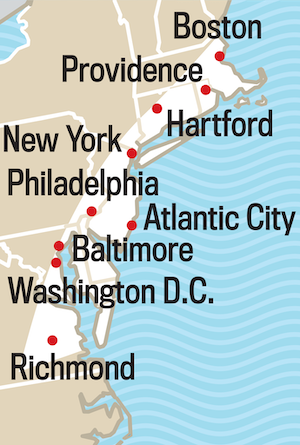
Region 2: Atlantic Corridor
This swath of land along the East Coast covers portions of seven states, including New York, Pennsylvania, and Virginia, as well as major cities from Boston and NYC to Washington, D.C., and Richmond.
How Cold Will Winter Be?
Not bad! Temperatures will be average to slightly above average during winter (though 2% colder than average during February). The region will also experience shots of cold in mid-December, early and late January, and late February.
Will There Be Snow?
Precipitation will be slightly below normal this winter. In this region, snowfall will be below normal in the north and above normal in the south. The most snow is expected to arrive in late December and late February.
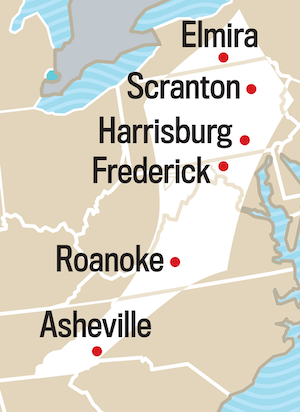
Region 3: Appalachians (including Pennsylvania and Virginia)
Thanks to the influence of the mountains, the Appalachian region has its own climate that stretches south from Elmira to Asheville. Winters tend to be cold and dry. This year’s winter should be more temperate than usual.
How Cold Will Winter Be?
Winter temperatures will be slightly warmer than normal, and below-normal precipitation is expected. The coldest periods will occur from mid-January into early February and in late February.
Will There Be Snow?
Precipitation will be below normal across the region. However, we expect average snowfall in the north and above-normal snowfall in the southern Appalachians. The snowiest periods will occur in late December, late February, and early March.
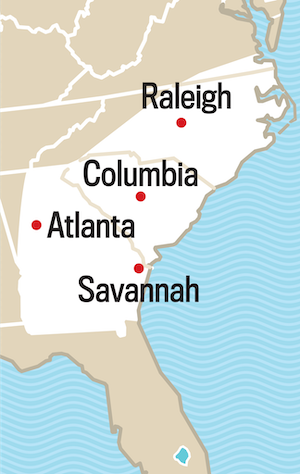
Region 4: Southeast: Georgia, South Carolina, North Carolina
How Cold Will Winter Be?
Winter will be cooler than normal in the east and warmer than normal in the west. The coldest periods are expected in late November, late January, and late February.
Will There Be Snow?
Precipitation and snowfall will be above normal. The best chance for snow is in late January and early and late February. Superbowl 2025 is set in New Orleans in early February; this may affect travel, though the Superdome is completely covered.
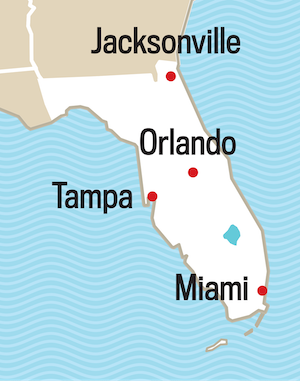
Region 5: Florida
How Cold Will Winter Be?
Winter will be cooler than usual for the most part: February is expected to be 3°F above average, with near-average temperatures for the rest of the season. The coldest periods are expected in the later parts of November, December, January, and February.
Will There Be Snow?
Snowfall is not expected, however, rainfall will be slightly above normal across the state of Florida this winter.
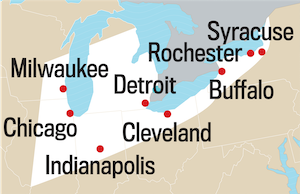
Region 6: Lower Lakes: Calling Illinois and Michigan!
Think “lake effect” snow for the Lower Lakes region. This area includes states that surround some of our Great Lakes, including Wisconsin, Illinois, Indiana, Michigan, New York, Ohio, and Pennsylvania.
How Cold Will Winter Be?
Winter will be warmer than normal in the east and colder than normal in the west. The coldest periods are expected in early and late November, in early December, and from late January into early February.
Will There Be Snow?
Precipitation will be below normal in the Lower Lakes region this winter. Snowfall will also be below average, with the most snow in late December, from late January into early February, and from late February into early March.
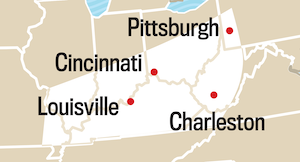
Region 7: Ohio Valley (Ohio, Indiana, Illinois, Kentucky, West Virginia)
This winter, the Ohio Valley will see a small band of snow in an otherwise dry central and northeastern U.S. Indeed, “snow is a poor man’s fertilizer” for these agriculturally-heavy states.
How Cold Will Winter Be?
Winter will be colder than normal, especially in the month of February (4°F below average). The coldest blasts of winter will come in late January through early February and in late February.
Will There Be Snow?
The Ohio Valley will experience above-normal snowfall except for the furthest eastern areas, which will see below-normal amounts. The snowiest periods will be in late December, from late January into early February, in late February, and mid-March.
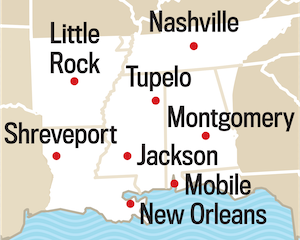
Region 8: Deep South
Wet and wild? Or, is that wet and mild? Across the Deep South, which covers Louisiana, Mississippi, Arkansas, Tennessee, and nearby states, there will be plenty of moisture and an extra dose of warmth this winter.
How Cold Will Winter Be?
Winter temperatures will be consistently warmer than average (about 2°F monthly). The coldest periods will occur in early and late November, from late January into early February, and in late February.
Region 9: Upper Midwest
If you’re a roofer in Minnesota, you know winter! This northern-tier region comprises Minneapolis and other cities, including International Falls to the north and Marquette and Green Bay to the east.
How Cold Will Winter Be?
It’s cold in the Upper Midwest, but winter 2024-2025 will NOT be as cold as usual. The coldest shots will occur in early November, early and late January, late February, and early March.
Will There Be Snow?
Precipitation and snowfall will be below average for the Upper Midwest, with the snowiest periods in late November, late December, mid- and late January, early February, and mid-March.
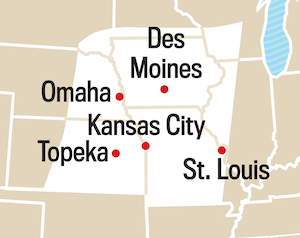
Region 10: Heartland
The heartland of America mainly covers Iowa, Missouri, and eastern Kansas, as well as Nebraska. Cities include Des Moines, St. Louis, Kansas City, Omaha, and Topeka.
How Cold Will Winter Be?
Winter will be warmer than normal throughout this agricultural area. The coldest periods in the heartland will occur in late January and early and late February.
Will There Be Snow?
Precipitation and snowfall will be below normal as well. The most snow will fall when temperatures are coldest in late January as well as early and late February.
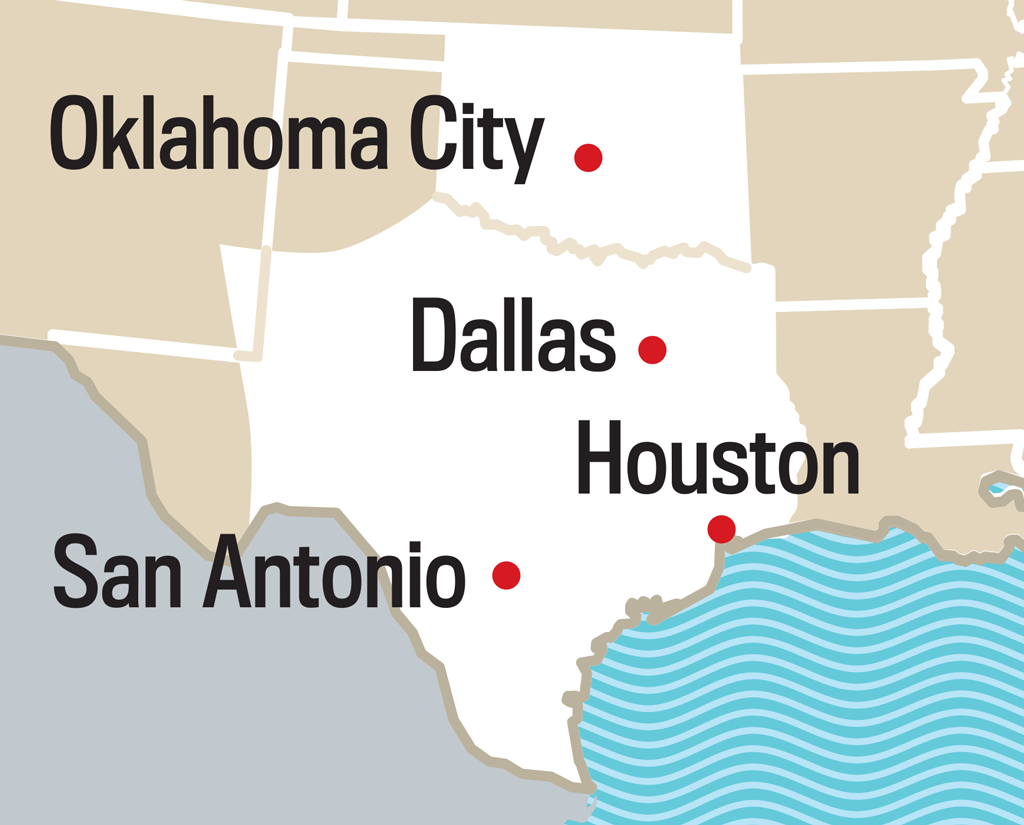
Region 11: Texas and Oklahoma
This region covers most of Texas (except for the far west) as well as central and eastern Oklahoma. Think San Antonio, then travel east to Houston and north to Oklahoma City.
How Cold Will Winter Be?
In terms of temperature, winter will be warmer than average, with the coldest periods in late January and early and late February. We all remember the extreme ice storms and power outages that afflicted this region two years ago; thankfully, the weather this winter doesn’t look as extreme.
Will There Be Snow?
Precipitation will be below normal, so expect it to be drier than average this winter in Texas and Oklahoma. The best chances for snow are expected in early and late February.
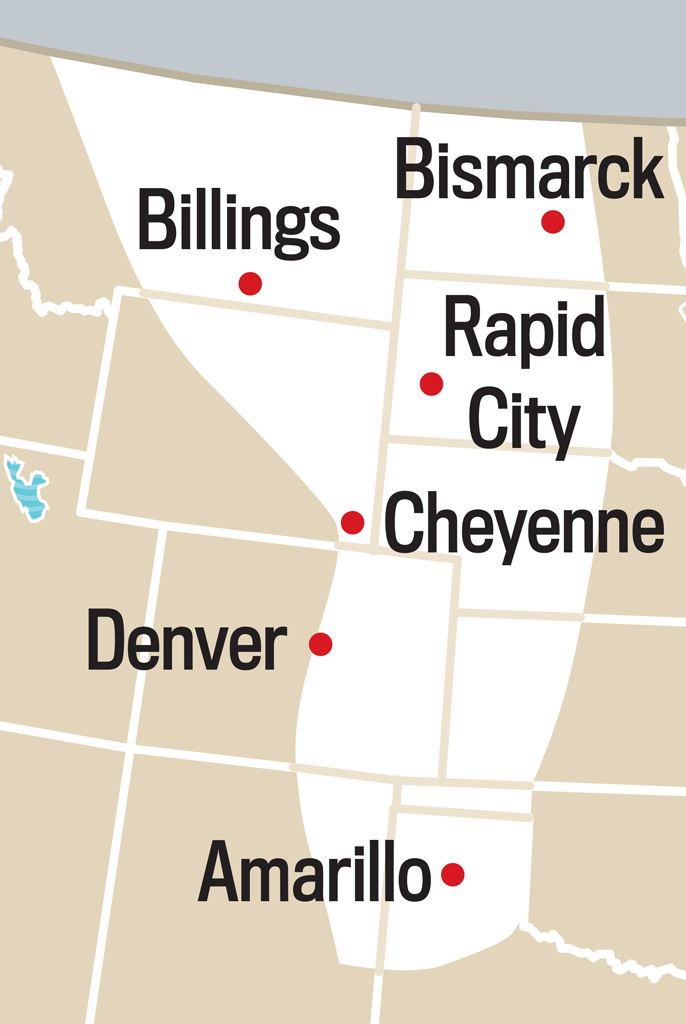
Region 12: High Plains
This region, located just to the east of the Rocky Mountains, covers America’s broad expanses of flatland. It extends from Amarillo north through Denver to Billings and east to Bismarck.
How Cold Will Winter Be?
Winter temperatures will be warmer than normal in the northern parts of this region—and colder than normal in the southern areas. Expect the coldest periods in early and mid-January and early to late February.
Will There Be Snow?
Precipitation will be near normal, so don’t expect extremes. Snowfall will be near to above normal, with the snowiest periods in mid-November, mid- and late January, and late February.
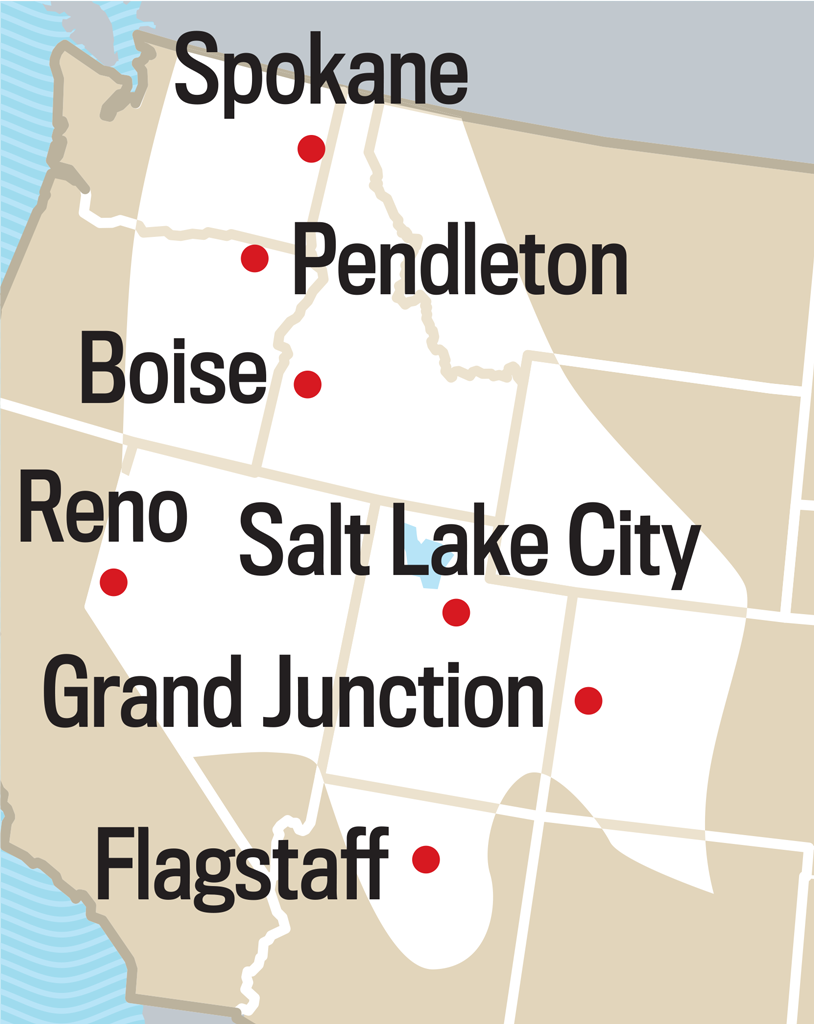
Region 13: Intermountain (Utah, Colorado, Idaho, and more)
With much of the country showing drier-than-average conditions, folks in the western Rocky Mountains will enjoy a snowy winter! We’re looking at you, Utah, Colorado, and Lake Tahoe in California.
Will There Be Snow?
Yes! Precipitation and snowfall will be average or above average throughout the Intermountain Region. The snowiest periods will fall in mid-November, early and late January, and mid-March.
How Cold Will Winter Be?
Winter won’t be especially frigid, with temperatures above normal. The coldest periods are in late November and late January.
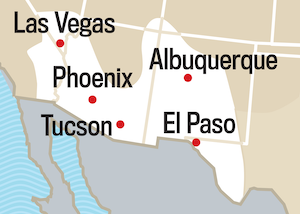
Region 14: Desert Southwest: Arizona, New Mexico, Las Vegas
How Cold Will Winter Be?
Temperatures will be colder than normal throughout the winter, with a few monthly variations. January is 3°F above average and March is 3°F below average. The coldest periods will be in mid-November, mid- to late December, and early February.
Will There Be Snow?
Expect above-average rainfall. Snowfall will be above normal in areas that normally receive snow, with the snowiest periods in mid-December and early February.
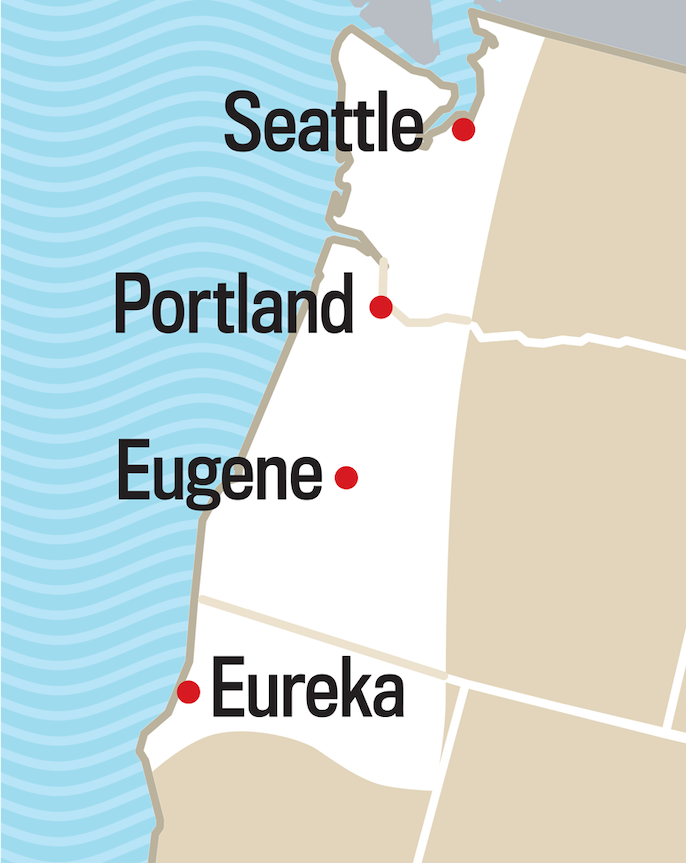
Region 15: Pacific Northwest
The northwest corner of the United States, famous for its consistent precipitation, spans from Washington through Oregon to Eureka in northern California.
Will There Be Snow?
Precipitation and snowfall will be above average in the north and below average in the south. The snowiest periods will be late December, early January, and early February.
How Cold Will Winter Be?
Winter temperatures will be colder than normal in the north and warmer in the south. The coldest periods will fall in early and late January and early March.
For monthly details—and 12 months of weather predictions—order your copy of The 2025 Old Farmer’s Almanac!
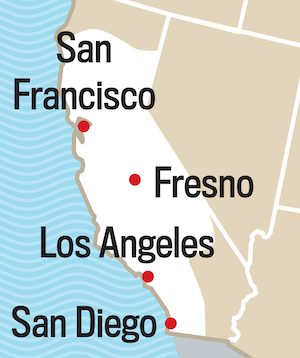
Region 16: Pacific Southwest (California)
This region covers the state of California, except for the most northern area. Our Pacific coast has faced many challenges, from drought to excessive rain and wildfires. What’s in store for this winter?
How Cold Will Winter Be?
Winter will be warmer than normal throughout the region. The coldest temperatures will occur in mid-December and mid- to late January.
Will There Be Snow?
Expect lots of moisture with a wetter-than-normal winter throughout the entire state of California, with above-normal mountain snowfall. The stormiest periods will be in mid-December, early January, and mid- and late February.
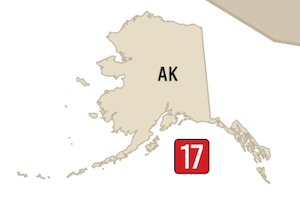
Region 17: Alaska
Winter will not be as cold as usual—and coldest in December and early January. Precipitation will be below normal. The south and west of this region will see more snow than usual; expect less snow in the north and east. It will be snowiest in late November, December, and early and late January.
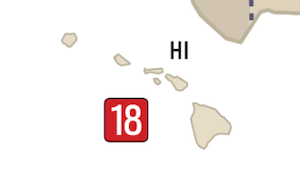
Region 18: Hawaii
Winter will be slightly warmer than usual (1% above average) in pleasant Hawaii. The coolest periods will be early and late November, mid-January, and mid-February. The skies will be drier than usual in the east and wetter in central and western areas. It will be stormiest in early November, early January, and early to mid-March.
Stay tuned as we reveal the rest of our 2024-2025 winter forecasts, ramping up to the official release of The 2025 Old Farmer’s Almanac on Tuesday, August 27!
Be the first to get your 2025 Almanac!
Now in its 233nd year, The Old Farmer’s Almanac is the best-selling annual in the United States. Order the 2025 edition today!

What Is Shaping Our Winter Forecasts This Year?
The Sun is reaching the maximum of Solar Cycle 25. What does this mean? Halfway through its 11-year solar cycle, the Sun’s activity grows intensely hot and stormy. Think of the solar maximum as similar to the peak of a hurricane season (except that the Sun’s storms last a few years!).
High solar activity levels have historically been linked to warmer temperatures, on average, across Earth—although this relationship has become weaker in recent decades.
The Old Farmer’s Almanac believes that the solar cycle and number of sunspots can influence the long-range weather here on Earth. Will the solar maximum in 2024–2025 mean a milder winter forecast? As discussed above, there are several weather disciplines that we use to make our long-range predictions. But certainly, a warming Sun plays a role.

Ocean Patterns & the Weather
Other factors that affect long-range weather include “oscillations,” which are recurrent ocean-atmospheric weather patterns. Our weather team watches water and wind oscillations in the Pacific, in the Atlantic, and along the Equator. These indicate neutral to warmer temperatures and perhaps normal to below-normal precipitation, with the potential for occasional cold arctic blasts.
If you have heard of El Niño and La Niña, these are the climate patterns that occur in the tropical Pacific Ocean, and are part of “ENSO” (the El Niño Southern Oscillation cycle). El Niño is the warm phase, while La Niña tends to be cooler. We’re expecting a neutral El Niño Southern Oscillation or possibly even a La Niña this winter, following a strong El Niño last year. At the same time, we’re anticipating a warm Atlantic Multidecadal Oscillation and a cool Pacific Decadal Oscillation. We’re also watching equatorial stratospheric winds known as the Quasi-Biennial Oscillation. Combinations of these factors can also cause the polar vortex to drop added flashes of cold into North America.
What Are Long-Range Forecasts?
The Old Farmer’s Almanac’s long-range predictions differ from the short-range forecasts that apply to the next few days. They are seasonal weather outlooks for the upcoming year. With the nature of our atmosphere, climate, and the Sun’s cycles, it is impossible to predict the weather a year ahead for a single day. However, we know that global weather systems and other factors will act to make some outcomes more likely than others, and we present the likeliest outcome of what might happen.
For example, for winter, we’ll predict whether this season’s temperatures will be colder—or warmer—or near normal for regions of the U.S. and Canada. Will our winter be drier or wetter than average? How much snow should we expect? These are the kinds of questions we answer in our long-range seasonal predictions.
Long-range forecasts are for the planners among us—the gardeners and farmers, the truckers and shippers, businesses that have financial exposure to weather, vacationers, and all of us everyday weather watchers who stock up on fuel and ready our snow shovels or umbrellas!
How Do We Predict the Weather?
Ever since our first edition in 1792, The Old Farmer’s Almanac has used a unique, proprietary method of predicting weather that we still use today, though nowadays we use modern technology! We employ three scientific disciplines:
- Solar science, the study of sunspots (magnetic storms on the Sun’s surface);
- Climatology, the study of prevailing weather patterns; and
- Meteorology, the study of the atmosphere (what short-range weather forecasters do).
We predict weather trends and events by comparing solar patterns and historical weather conditions with current solar activity. We’re looking at “normals” or “averages” over decades, not just how the weather compared to last year. For the 2024-2025 winter season, our forecasts are based on the latest period, 1991 through 2020.
In every issue of The Old Farmer’s Almanac, we also provide a full report on “how we did” in our predictions for the prior winter. You can find this information in the 2025 copy.
Eager to get The 2025 Old Farmer’s Almanac—with 12 months of forecasts plus a healthy dose of wit and wisdom? Order now—and be assured of your 2025 copy!
Looking for the Canadian Edition? See our 2024–2025 Winter Weather Outlook for Canada.


